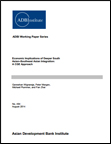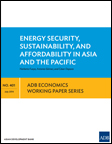Accumulating Trade Costs and Competitiveness in Global Value ChainsThis paper examines the implications of trade costs, including applied tariffs, transportation and insurance costs, on competitiveness at industry, national and global levels, and identifies where trade facilitation investment would have the highest social returns from the perspective of global value chains (GVCs). With trade costs amplified along GVCs, profitability of individual business operations are affected by incurred transaction expenses. The authors conclude that direct benefits of trade facilitation will be higher for countries that are not yet well integrated into international trade, but key traders who are at the core of GVCs also stand to gain much. Author: Antonia Diakantoni, Hubert Escaith, Michael Roberts and Thomas Verbeet Year: 2017 Download Tags: Trade, Tariff, Transport, Trade Facilitation, Global Value Chains World Tariff Profiles 2016World Tariff Profiles, a joint publication of the World Trade Organization (WTO), International Trade Centre, and the United Nations Conference on Trade and Development, provides comprehensive information on tariff parameters imposed by the 164 WTO members—including Bangladesh, India, Maldives, Myanmar, Nepal, and Sri Lanka— and other countries and Customs territories with available data on imports—including Bhutan, a WTO Observer. It contains individual country tariff profiles, and statistics on non-tariff measures in effect as of December 2015. This 2016 edition also contains a discussion of the 2017 Harmonized System, which will affect around 15% of goods traded globally. Author: World Trade Organization, International Trade Centre, and the United Nations Conference on Trade and Development Year: 2016 Download Tags: Tariff, Trade Facilitation, Customs Clean Energy and Access to Infrastructure: Implications for the Global Trade SystemThis paper focuses on how international trade rules could better accommodate renewable energy trade through fixed infrastructure. It explains the World Trade Organization disciplines relevant to trade in clean energy via fixed infrastructure, in particular General Agreement on Trade in Services disciplines on energy services and General Agreement on Tariffs and Trade transit rules. Finally, it suggests policy options to adopt existing rules to the challenges of integrating clean energy transported via fixed infrastructure. Author: International Centre for Trade and Sustainable Development Year: 2015 Download Tags: Energy, Trade, WTO, India, South Asia, Sustainability, Tariff Trade and Non-Tariff Measures: Impacts in the Asia-Pacific Region This study brings together existing evidence on the occurrence and trade impacts of non-tariff measures (NTMs) in the Asia-Pacific region. It aims to contribute to an improved understanding on their trade impacts on developing countries. The report focuses on the consequences of NTMs for developing economies and South-South trade. The chapters include an overview of tariff and non-tariff measures, an evaluation of NTMs and trade, and an examination of Sanitary and Phytosanitary Measures and Technical Barriers to Trade. Finally, the study concludes by reviewing mechanisms for streamlining NTMs and promoting developing countries’ trade, particularly at the regional level. Author: United Nations Economic and Social Commission for Asia and the Pacific Year: 2015 Download Tags: Asia-Pacific, Tariff, Trade, Sanitary and Phytosanitary Measures, Technical Barriers to Trade, UNESCAP World Tariff Profiles 2014This statistical yearbook devoted to market access for goods contains a comprehensive compilation of tariff parameters for each of the 160 World Trade Organization members, plus a number of other countries and customs territories where data is available. Each country profile presents information on tariffs
imposed by each economy on its imports, including an analysis of market access conditions in its major export markets. Statistics for all countries allow easy comparisons between countries and sectors, as well as between bound and applied tariffs. Author: World Trade Organization, International Trade Centre, and United Nations Conference on Trade and Development Year: 2014 Download Tags: WTO, Customs, Tariff, Bangladesh, India, Maldives, Nepal, Sri Lanka, Transport, Tariffs, Trade Impact of Trade Facilitation on Foreign Direct InvestmentThis United Nations Economic and Social Commission for Asia and the Pacific Trade and Investment Working Paper attempts to quantify the potential impact of trade facilitation on foreign direct investment (FDI) flows. The study uses bilateral FDI data from 2006 onward from both developing and developed countries, including South-South FDI flows, wherein contiguity (common border between source and host country) and geographic distance are found to be much more important factors. In applying an augmented FDI model framework to determine the effect of comprehensive international trade costs, the results show that both non-tariff and tariff costs are important determinants of FDI inflows. Author: Yann Duval and Chorthip Utoktham Year: 2014 Download Tags: FDI, Trade Facilitation, Bilateral Trade, UNESCAP, Investment, Tariff, Bangladesh, Maldives  Economic Implications of Deeper South Asian–Southeast Asian Integration: A CGE ApproachHigh tariff and non-tariff barriers, and costly transport links and inefficient trade facilitation measures continue to hamper the growth of trade between South Asia and Southeast Asia. This paper explores whether potential gains from improved connectivity—via Myanmar as inter-regional bridge—justify a high level of investment. Using an advanced computable general equilibrium (CGE) model, reduction of inter-regional tariffs, decreasing of non-tariff barriers by 50%, and cutting down of trade costs between South Asia and Southeast Asia by 15% yields a prediction of 8.9% rise in welfare in South Asia and Southeast Asia, and an increase of 6.4% in gross domestic product by 2030. Author: Ganeshan Wignaraja, Peter Morgan, Michael Plummer, and Fan Zhai Year: 2014 Download Tags: Transport, Trade Facilitation, South Asia, Southeast Asia, Regional Integration, Tariff, Trade, Connectivity, Investment, Myanmar, GDP  Energy Security, Sustainability, and Affordability in Asia and the PacificEnergy security, sustainability, and affordability from 2010 to 2035 for Asian Development Bank’s Asia and Pacific members are calculated in this working paper, including potential benefits of integrating energy systems regionally. Based on business-as-usual and alternative scenarios, outlook on SASEC member countries by 2035 include (i) dramatic improvement in Bhutan's energy efficiency, (ii) slight decrease in Bangladesh's energy intensity—although carbon dioxide will increase in its primary energy mix, as dependence on fossil fuels rise, and (iii) decrease in energy self-sufficiency of SASEC member countries by 2035, but improved energy affordability. Since renewable energy sources and importation of energy may be capital-intensive, requiring additional tariff support, regional cooperation can enhance affordability and energy security—with Bhutan and Nepal standing to benefit greatly from energy integration in South Asia. Author: Norberto Fueyo, Antonio Gómez, and César Dopazo Year: 2014 Download Tags: Energy, Bhutan, Nepal, Sustainability, Asia-Pacific, ADB, Regional Integration, SASEC, South Asia, Bangladesh, Sustainability, Renewables, Tariff, Regional Cooperation Simulating World Trade in the Decades Ahead: Driving Forces and Policy ImplicationsThis working paper considers economic prospects up to the year 2100, offering assumptions about key exogenous variables, providing a baseline for climate change policy evaluation, and discussing sectoral and trade issues. The paper combines an economic growth model with a multi-sectoral model to construct scenarios for around 150 countries up to a maximum time horizon of 2035, with forecasts on a number of key variables such as energy prices, demographics, etc. It suggests that trends toward increased regionalization may be reversed, with multilateral trade relationships gaining in importance. Author: Lionel Fontagné, Jean Fouré and Alexander Keck Year: 2014 Download Tags: Climate, Trade, Statistics, Trade Policy, Policy, Energy, Tariff, ASEAN, India, Environment |



